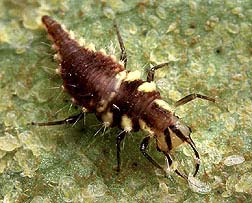Green Lacewing Larva

A green lacewing larva dines on whitefly nymphs. An ugly insect that is good for your garden.
Lacewing larvae are also known as aphid lions. They are tiny upon emerging from the egg, but grow to 3/8 of an inch long.
Lacewing larvae voraciously attack their prey by seizing them with large, sucking jaws and inject a paralyzing venom. The hollow jaws then draw out the body fluids of the pest. Of all available commercial predators, this lacewing is the most voracious and has the greatest versatility for pests of field crops, orchards, and greenhouses.
Each lacewing larva will devour 200 or more pests or pest eggs a week during their two to three week developmental period. After this stage, the larvae pupate by spinning a cocoon with silken thread. Approximately five days later adult lacewings emerge to mate and repeat the life cycle. Depending on climatic conditions, the adult will live about four to six weeks.
Resource: Beneficial Insectary, Inc.